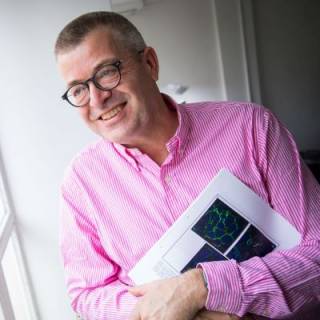Professor Andreas Schätzlein and colleagues are using sophisticated chemical engineering to get cancer therapeutics into the body - and to the right parts of the body, including the brain.
Many types of chemotherapeutic have been designed to interfere with the biology of cancer cells. A further challenge is to ensure that these agents reach cancer cells at concentrations high enough to be effective but remain low enough in other parts of the body so that they do not trigger toxicity by damaging healthy body cells.
A veterinary medicine graduate turned cancer researcher, Professor Schätzlein has focused on novel drug delivery mechanisms addressing this challenge. With Professor Ijeoma Uchegbu and colleagues, he has delivered novel nanoparticle systems for delivering a range of cancer therapeutics - from small-chemical compounds to nucleic acids.
Among the most promising tools are nanoparticles based on chitosan, a polymer derived from the shells of crustaceans. Readily amenable to chemical modification, chitosan polymers can be turned into amphiphilic molecules - part hydrophobic, part hydrophilic - that naturally self-assemble into nanometre-sized particles. The hydrophobic core of these particles can encapsulate drug compounds that are poorly water-soluble, such as lipophilic drugs and peptides, and thus hard to get into the body.
Furthermore, these particles are particularly adept at getting compounds across key biological barriers. For example, by facilitating transport across the gut wall, nanoparticle packaging has enabled drugs traditionally delivered by injection to be given in tablet form. Professor Schätzlein's team has also worked with a US company to enhance delivery of a new class of poorly soluble drug into the body.
Particularly exciting is the potential use of nanoparticles to deliver drugs to the brain. The blood-brain barrier is a major obstacle to the delivery of brain tumour chemotherapeutics - requiring high drug concentrations that generate significant toxicity, particularly on bone marrow. In animal models, packaging of the anti-cancer drug lomustine increased the amounts of drug reaching the brain and reduced bone marrow toxicity - and, importantly, significantly enhanced survival [1].
The same approach has been used to deliver a modified peptide with pain-killing properties, leu-enkephalin (LENK), into the brain. When injected directly into the bloodstream, LENK is rapidly degraded and has no analgesic effect, but delivered in nanoparticles it is a highly effective painkiller [2].
Professor Schätzlein's team has also explored an innovative new route of delivery for this peptide (and other drugs) that would avoid the need for injection - intranasal administration. The olfactory nerve provides a route from the back of the nose into the brain that is not bordered by the blood-brain barrier. This approach has provided a way to deliver LENK to the brain [3] and could be used to administer analgesics in advanced cancer, or even adapted to deliver anti-cancer drugs to the brain.
His team is also contributing to a £5.7m EPSRC-funded programme led by Professor Nicholas Stone (Exeter) aiming to develop targeted nanoparticles suitable for both non-invasive imaging and cancer therapy [4]. As well as adapting his own nanoparticle systems, integrating structures to recognise target antigens, his group will also be working with other types of nanoparticle developed by collaborators, including gold nanoparticles. The targeted particles will be modified so that binding can be visualised using harmless near-infrared light, which could also be used to trigger the release of an anti-cancer drug at tumour sites.
Cancer gene therapy
More than a decade ago, Professor Schätzlein developed polymer-based packaging for nucleic acids, for potential use in gene therapy [5]. 'Dendrimers' and other positively charged polymers that bind strongly to negatively charged nucleic acids, forming compact nanoparticles that can act as synthetic vectors. Despite early evidence that these particles show an affinity for tumours [6] and can facilitate the delivery of an anti-tumour gene leading to tumour regression [7], until recently there has been little interest in their clinical development.
Although widely used in the laboratory to transfect cells, current synthetic vectors have proven too toxic for use in humans. However, Professor Schätzlein and colleagues have been refining their chemical properties to maintain their capacity to transfect tumour cells, improve their stability, and minimise their impact on other body cells [8]. Notably, these carriers are also compatible with intranasal delivery to the brain via the olfactory nerve.
One example of their use could be the delivery of short RNAs, which can reduce the expression of target genes by binding to specific messenger RNA transcripts, leading to their degradation. Using this approach, Professor Schätzlein and colleagues delivered RNAs that knocked down levels of a protein associated with resistance to the chemotherapeutic gemcitabine [9] - a possible way to overcome a common mechanism of drug resistance encountered in treatment of pancreatic cancer.
- Fisusi FA et al. lomustine nanoparticles enable both bone marrow sparing and high brain drug levels - a strategy for brain cancer treatments. Pharm Res. 2016;33(5):1289-303.
- Lalatsa A et al. Chitosan amphiphile coating of peptide nanofibres reduces liver uptake and delivers the peptide to the brain on intravenous administration. J Control Release. 2015;197:87-96.
- Godfrey L et al. Nanoparticulate peptide delivery exclusively to the brain produces tolerance free analgesia. J Control Release. 2018;270:135-144.
- http://gtr.ukri.org/projects?ref=EP%2FR020965%2F1
- Dufès C, Uchegbu IF, Schätzlein AG. Dendrimers in gene delivery. Adv Drug Deliv Rev. 2005;57(15):2177-202.
- Chisholm EJ et al. Cancer-specific transgene expression mediated by systemic injection of nanoparticles. Cancer Res. 2009;69(6):2655-62.
- Dufès C et al. Synthetic anticancer gene medicine exploits intrinsic antitumor activity of cationic vector to cure established tumors. Cancer Res. 2005;65(18):8079-84.
- Simão Carlos MI et al. Limiting the level of tertiary amines on polyamines leads to biocompatible nucleic acid vectors. Int J Pharm. 2017;526(1-2):106-124.
- de la Fuente M et al. A nano-enabled cancer-specific ITCH RNAi chemotherapy booster for pancreatic cancer. Nanomedicine. 2015;11(2):369-77.
 Close
Close


